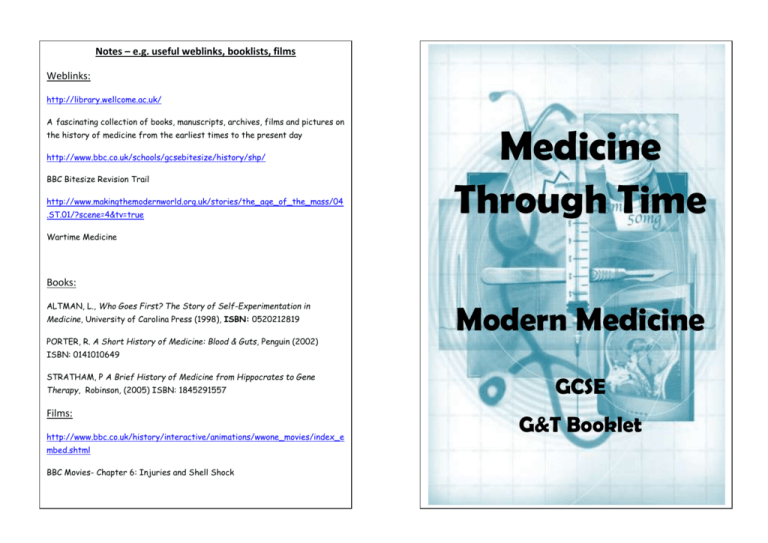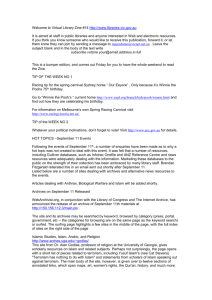Medicine Through Time later years
advertisement

Notes – e.g. useful weblinks, booklists, films Weblinks: http://library.wellcome.ac.uk/ A fascinating collection of books, manuscripts, archives, films and pictures on the history of medicine from the earliest times to the present day http://www.bbc.co.uk/schools/gcsebitesize/history/shp/ BBC Bitesize Revision Trail http://www.makingthemodernworld.org.uk/stories/the_age_of_the_mass/04 .ST.01/?scene=4&tv=true Medicine Through Time Wartime Medicine Books: ALTMAN, L., Who Goes First? The Story of Self-Experimentation in Medicine, University of Carolina Press (1998), ISBN: 0520212819 PORTER, R. A Short History of Medicine: Blood & Guts, Penguin (2002) Modern Medicine ISBN: 0141010649 STRATHAM, P A Brief History of Medicine from Hippocrates to Gene Therapy, Robinson, (2005) ISBN: 1845291557 Films: http://www.bbc.co.uk/history/interactive/animations/wwone_movies/index_e mbed.shtml BBC Movies- Chapter 6: Injuries and Shell Shock GCSE G&T Booklet (1) (6) The Fight Against Disease Health and the Local Community Task One: Welcome to Task One: Gloucestershire! Imagine you are visiting the county of Gloucestershire, the home of Edward Jenner, at the start of the nineteenth century. It is your job to design a tourist brochure to promote the area. Include the details about Jenner’s famous discovery and highlight its impact on the local community. Go to the Folkestone Library and find the local history reference book containing the title ‘Cholera in Sandgate 1854’ (reference code 614.514 LOCAL). Make some notes on what you can learn from the illustration about the impact of a cholera outbreak on the local community. Use these notes to write a short diary entry on the experience of a local person during the 1854 outbreak. How do you feel? Have your family or friends caught the disease? How many have died? What is being done to control the spread of disease, if anything? Task Two: Task Two: In the late nineteenth century, the French government gave Louis Pasteur generous funding for his research into the cause of disease. This not only shows how important his work was but also reflects the fact that they wanted Pasteur to do better than their enemies, the Germans. Produce a song or a rap that charts the development of public health from the start of the Industrial Revolution in the eighteenth century to the introduction of the NHS in 1948… and even beyond! Using the internet, research the ways in which the two countries were in competition with each other. Refer in your answer to the different methods each scientist used to study germs and the international context of their rivalry with brief details of the Franco-Prussian War. You can include the work of Edwin Chadwick and John Snow, the 1875 Public Health Act, the 1911 National Insurance Act and the role of Nye Bevan. Choose whether to sing your song on your own or teach it to a group in your class to perform together. (5) (2) Public Health and Disease The Importance of the Individual Task One: Task One: Imagine you have been asked to write an audio guide or pod cast describing a visit to London in the 1800s. Explain what you see and list all of the things that are a potential risk to public health. Use the website http://kesr.org.uk/help-the-railway/cavell-vanrestoration.html to look into the history of the Cavell van, which played an important part in medical history during the First World War. Refer to sanitation, water supplies, crowding, street cleanliness and suggest ways these could be improved. Make a poster on the van and the three people connected to it, the nurse Edith Cavell, Captain Charles Fryatt and the Unknown Warrior. Become the teacher in your lesson and give a presentation to your class on what you have learnt and produce a fact sheet that contains additional information from the poster. Write a short minute long commentary of your visit and print out the transcript. Task Two: Task Two: Study this cartoon of a cholera patient experimenting with remedies for the disease (a bigger picture can be found at http://images.wellcome.ac.uk/). Annotate the drawing with all the information you can get from it. Consider: -what you can learn from the cartoon -why it might not be reliable - the role of public health in the fight against cholera (positive? negative?) -who the author is and what his reasons might have been for producing this drawing In 1945 Sir Alexander Fleming, Ernst Chain and Howard Florey shared the Nobel Prize for Physiology and Medicine for their role in the development and mass production of penicillin which saved millions of lives during the course of the Second World War. However, another member of the team- Norman Heatley- was the one who devised a way of purifying this very unstable substance yet did not receive any recognition. Investigate his work and make a judgement on the importance of his contribution. Write a letter to the Nobel organisation either saying why you think they made the right choice or argue the case for Norman Heatley’s claim to a Nobel Prize. (3) (4) Developments in Surgery Medical Pioneers Task One: Task One: James Simpson’s discovery of the anaesthetic chloroform in 1847 was only possible because he was willing to experiment on himself. Read through the list of Nobel Prizes winners of Physiology and Medicine on the Nobel Prize website (http://www.nobelprize.org/nobel_prizes/medi cine/laureates/). Chose one person from the list and use the internet to research them. What did they win a Nobel Prize for? Did they share the award with anyone else? Is their discovery still important today? The story of Simpson using himself as his own ‘guinea pig’, however, is by no way the only one in the history of medicine. Read the chapter on the role of self-experimentation in the development of anaesthesia and make a list of the reasons why some doctors risked their own health, and lives, in this way. Task Two: Many advances in surgery and anatomy have been made possible by the outbreak of war throughout the history of medicine and health. Research the ways in which the First World War provided opportunities for the development of surgery and choose one topic to create a fact sheet. Choose from: - Psychiatry Blood transfusion Artificial limbs Facial reconstruction X-rays Which area of surgery do you think benefitted most from wartime advances? Did any areas suffer setbacks due to the war? Produce a presentation for your class on your chosen winner explaining what you have learnt and whether you think they were deserving of the award. Task Two: Design your own Top Trumps cards for the medical pioneers of modern medicine. Choose at least six people who you think have had a great impact on medicine and make a fact file on them. You can use the following points and rank each one from 1 (least important) to 10 (most important): - Details of their work (was it a new discovery or a development of someone else’s?) Number of lives saved (approximately) Method used (scientific?) Impact of development on other doctors (did it inspire other discoveries?) Durability (has the discovery stood the test of time?) Make a judgement on which person is most important in the development of medicine and explain why.











